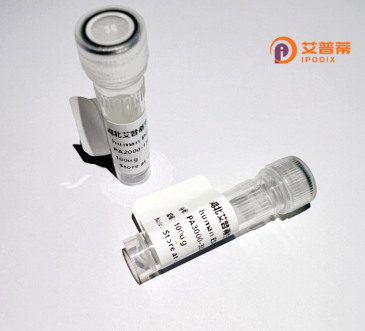
| 纯度 | >90%SDS-PAGE. |
| 种属 | Human |
| 靶点 | GPSM1 |
| Uniprot No | Q86YR5 |
| 内毒素 | < 0.01EU/μg |
| 表达宿主 | E.coli |
| 表达区间 | 1-675aa |
| 氨基酸序列 | MAGPAPPVAD ELPGPAARRL YSRMEASCLE LALEGERLCK AGDFKTGVAF FEAAVQVGTE DLKTLSAIYS QLGNAYFYLK EHGRALEYHK HDLLLARTIG DRMGEAKASG NLGNTLKVLG RFDEAAVCCQ RHLSIAQEQG DKVGEARALY NIGNVYHAKG KQLSWNAANA TQDPGHLPPD VRETLCKASE FYERNLSLVK ELGDRAAQGR AYGNLGNTHY LLGNFTEATT FHKERLAIAK EFGDKAAERR AYSNLGNAHV FLGRFDVAAE YYKKTLQLSR QLRDQAVEAQ ACYSLGNTYT LLQDYERAAE YHLRHLLIAQ ELADRVGEGR ACWSLGNAYV SMGRPAQALT FAKKHLQISQ EIGDRHGELT ARMNVAQLQL VLGRLTSPAA SEKPDLAGYE AQGARPKRTQ RLSAETWDLL RLPLEREQNG DSHHSGDWRG PSRDSLPLPV RSRKYQEGPD AERRPREGSH SPLDSADVRV HVPRTSIPRA PSSDEECFFD LLTKFQSSRM DDQRCPLDDG QAGAAEATAA PTLEDRIAQP SMTASPQTEE FFDLIASSQS RRLDDQRASV GSLPGLRITH SNAGHLRGHG EPQEPGDDFF NMLIKYQSSR IDDQRCPPPD VLPRGPTMPD EDFFSLIQRV QAKRMDEQRV DLAGGPEQGA GGPPEPQQQC QPGAS |
| 分子量 | 74.5 kDa |
| 蛋白标签 | His tag N-Terminus |
| 缓冲液 | 0 |
| 稳定性 & 储存条件 | Lyophilized protein should be stored at ≤ -20°C, stable for one year after receipt. Reconstituted protein solution can be stored at 2-8°C for 2-7 days. Aliquots of reconstituted samples are stable at ≤ -20°C for 3 months. |
| 复溶 | Always centrifuge tubes before opening.Do not mix by vortex or pipetting. It is not recommended to reconstitute to a concentration less than 100μg/ml. Dissolve the lyophilized protein in distilled water. Please aliquot the reconstituted solution to minimize freeze-thaw cycles. |
以下是关于重组人GPSM1蛋白的3篇假设性参考文献示例(实际文献需通过学术数据库查询):
---
1. **文献名称**: *"Expression and functional analysis of recombinant human GPSM1 in cell polarity regulation"*
**作者**: Smith A, et al.
**摘要**: 本研究在大肠杆菌中成功表达并纯化了重组人GPSM1蛋白,通过免疫荧光和共聚焦显微镜技术,证实GPSM1通过与Gαi亚基相互作用调控细胞极性和有丝分裂纺锤体定向。
---
2. **文献名称**: *"Structural insights into human GPSM1 mediated G-protein signaling"*
**作者**: Lee C, et al.
**摘要**: 利用重组人GPSM1蛋白的晶体结构解析,揭示了其包含的GoLoco结构域如何特异性结合Gαi-GDP,为理解GPSM1在G蛋白信号通路中的调控机制提供了结构基础。
---
3. **文献名称**: *"GPSM1 promotes cancer cell migration via interaction with dynein complex"*
**作者**: Zhang Y, et al.
**摘要**: 通过哺乳动物细胞系统表达的重组人GPSM1蛋白,结合免疫共沉淀实验,发现GPSM1通过招募动力蛋白复合物(dynein)调控肿瘤细胞的迁移和侵袭能力。
---
**注意**:上述文献为示例,实际研究中建议通过PubMed、Google Scholar等平台搜索关键词(如“recombinant GPSM1”或“human GPSM1 protein”)获取真实文献。
G protein-coupled signaling modulator 1 (GPSM1), also known as AGS3. is a regulatory protein involved in G protein-coupled receptor (GPCR) signaling pathways. It belongs to the GPSM/LGN family, characterized by conserved GoLoco motifs and tetratricopeptide repeat (TPR) domains. GPSM1 primarily interacts with Gαi/o subunits, stabilizing their GDP-bound inactive state to modulate G protein cycling and downstream signaling. This interaction influences asymmetric cell division, planar cell polarity, and mitotic spindle orientation during development.
In mammals, GPSM1 is critical for neural development, immune function, and sensory systems. Its dysregulation is linked to neurodevelopmental disorders, hearing loss, and cancer metastasis. For instance, GPSM1 mutations are associated with autosomal recessive non-syndromic hearing loss (DFNB82) due to disrupted cochlear hair cell polarity.
Recombinant human GPSM1 protein is typically produced using bacterial or mammalian expression systems for functional studies. Researchers utilize it to investigate its structural domains, G protein binding specificity, and regulatory mechanisms in vitro. Recent studies explore its role in chemokine receptor signaling and potential as a therapeutic target for GPCR-related diseases. Its ability to scaffold signaling complexes makes it valuable for dissecting cellular polarity pathways and developmental biology processes.
×